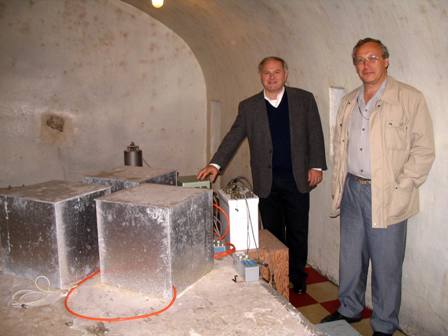GSN in Russia: 20th Anniversary
A team from the Global Seismographic Network (IRIS, USGS, UCSD, and associates) traveled to Russia August 24 - September 3 to visit the Geophysical Survey of the Russian Academy of Sciences (GS RAS) to renew our long and successful collaboration. September marks the twentieth anniversary of the first IRIS GSN station installed at Obninsk by the IRIS/IDA group at USCD. The meetings with Russian colleagues in both Obninsk and Moscow reflected upon this great long friendship. Hosted by Alexey Malovichko, Director of GS RAS, and Oleg Starovoit, Vice Director and colleague since the earliest days of GSN collaboration, the GSN met in Obninsk seeking ways to improve collaboration in the face of apparent challenges in customs and data flow. Substantial success was achieved.
To help resolve customs issues, GS RAS has proposed to purchase the GSN next-generation data acquisitions systems for GSN stations in Russia, and purchase replacements for the equipment damaged by a fire at the GSN site in Magadan. GS RAS has asked the Russian government to re-consider it restrictions on 40 sps real-time GSN data. Archival access to restricted data is granted after two weeks. GS RAS has proposed efforts to restore the GSN station at Norilsk (which has been down for 9 years) and is actively reviewing noise problems at other sites. GS RAS is receptive to broadening data exchange and establishing GSN quality instruments at additional Russian sites to complement GSN coverage. GSN and GS RAS reached consensus on a revised Memorandum of Understanding, which when signed by next March, will extend Russian and US collaboration in seismology and geodynamics for another ten years.
The occurrence of the Lake Baykal earthquake (M 6.3) during the meeting in Obninsk was good serendipity, and helped IRIS and USGS showcase the immediacy of real-time time data (broadband seismograms from 1019 stations were available at the IRIS DMS) and USGS NEIC data products.
In Moscow, there were friendly and engaging scientific discussions at the Russian Academy of Sciences with Academician N. Laverov and his staff, at the Institute of Dynamics of the Geospheres with Professor V. Adushkin and his staff, and with Academician A. Gliko of the Institute of Physics of the Earth and his staff.
The GSN operates 12 seismic stations in Russia. Six stations in Western Russia and Siberia are part of the IRIS/IDA network of the University of California at San Diego. Six stations in the Russian Far East are part of the IRIS/USGS network of the USGS Albuquerque Seismological Laboratory (ASL).
The GSN Team visits the Geophysical Survey of the Russian Academy of Sciences in Obninsk. (left to right) Front: Lind Gee, USGS ASL; Sue McLafferty, Honeywell TSI ASL; David Simpson, IRIS; Rhett Butler, IRIS GSN; Oleg Starovoit, GS RAS. Back: Mikhail Kogan, Lamont; Grigory Steblov, GS RAS; Alexey Malovichko, GS RAS Director; Anatoly Korotin, GS RAS; Peter Davis, UCSD IDA; David Chavez, UCSD IDA; Vladimir Mishatkin, GS RAS; John Derr, USGS ASL; Kent Anderson, IRIS GSN. Not shown: Dmitry Mekhrushev, GS RAS and Irina Gabsatarova, GS RAS.

Peter Davis, USCD IDA, and Dmitry Mekhrushev, GS RAS, stand by the GSN OBN equipment in the Obninsk vault. The three STS-1 components are thermally shielded on the pier at the left, the CMG-3T is in the background, and the data acquisition equipment is at the right. The OBN station is the first GSN site in Russia, initially installed in 1988.
Smiles in Obninsk. (left to right) Rhett Butler, IRIS Global Seismographic Network Program Manager; Lind Gee, USGS Scientist-in-Charge, Albuquerque Seismological Laboratory; and Alexey Malovichko, Director of the Geophysical Survey of the Russian Academy of Sciences.





